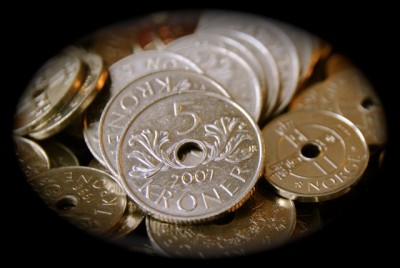Norway’s currency, the krone, has weakened considerably against the US dollar in the past several days. Analysts mostly blame lower oil prices, but one Norwegian economist notes that the inflationary effects of a weaker krone are now mostly “behind us.”

The price of a barrel of Norway’s North Sea Brent crude oil remained low on Monday, at USD 44.90 as of mid-morning. On Friday, it closed at USD 44.86, its lowest level since August 10.
Declines in oil prices are rarely if ever good for Norway’s oil-fueled economy, which has been shaken since the value of its most important export product toppled from levels of more than USD 100 just two years ago. Financial news service TDN Finans noted on Monday that oil prices dipped again in recent days after Iran increased its oil production. Bloomberg News, meanwhile, reported that US oil companies raised their number of active drilling rigs to the highest level since February.
Supply high and demand low
There’s still too much supply and not enough demand to push oil prices up, and that sends the value of Norway’s currency down, even amidst reports that interest rates may soon climb. Several Norwegian banks have already boosted home mortgage rates slightly, and some analysts think the central bank board may raise rates in December even though Norges Bank’s governor has stated repeatedly that rates will remain low in general for the foreseeable future.
On Monday morning, the US dollar had strengthened against the krone once again. It cost NOK 8.46 to buy one US dollar, up from NOK 8.18 earlier last week. The weaker krone has already led to visibly higher prices on imported goods on Norwegian shelves.
The chief economist at Nordea Norge, Norway’s second-largest bank, told newspaper Dagens Næringsliv (DN) just before the weekend, however, that the inflationary effect of a weaker kroner has likely topped out. Kjetil Olsen of Nordea thinks price growth will now level off,
“We predict that the price growth will ease,” Olsen told DN. Even though the price of clothing alone rose 2.3 percent from September to October, he doesn’t think clothes, for example, will get more expensive. “That was completely normal seasonal variation,” he said of the recent rise. “New collections are coming in for the autumn and winter, so prices jump from month to month.”
Higher electricity rates can hurt
Norway’s consumer price index for October, adjusted for increases in energy rates and taxes, was up 0.2 percent from September and showed a 12-month change of 2.9 percent in October. That’s a bit lower than what the central bank had expected. Olsen thinks the underlying inflation rates topped out in July.
Electricity rates, however, have been rising as temperatures have fallen, “and that may influence folks’ purchasing power,” Olsen said. “Especially now, after a dry autumn. Electricity rates influence the consumer price index quite a lot.” It hit 3.7 percent when electricity rates were factored in, and monthly bills including the price for and taxes on both the nett (network) and electricity itself have risen nearly 30 percent during the past 12 months, Olsen said.
He maintains, though, that other prices may even be on the way down. “Both we and Norges Bank believe the effect of the krone’s weakness will ease, and that price growth will dampen a bit. The peak is behind us.”
newsinenglish.no/Nina Berglund

